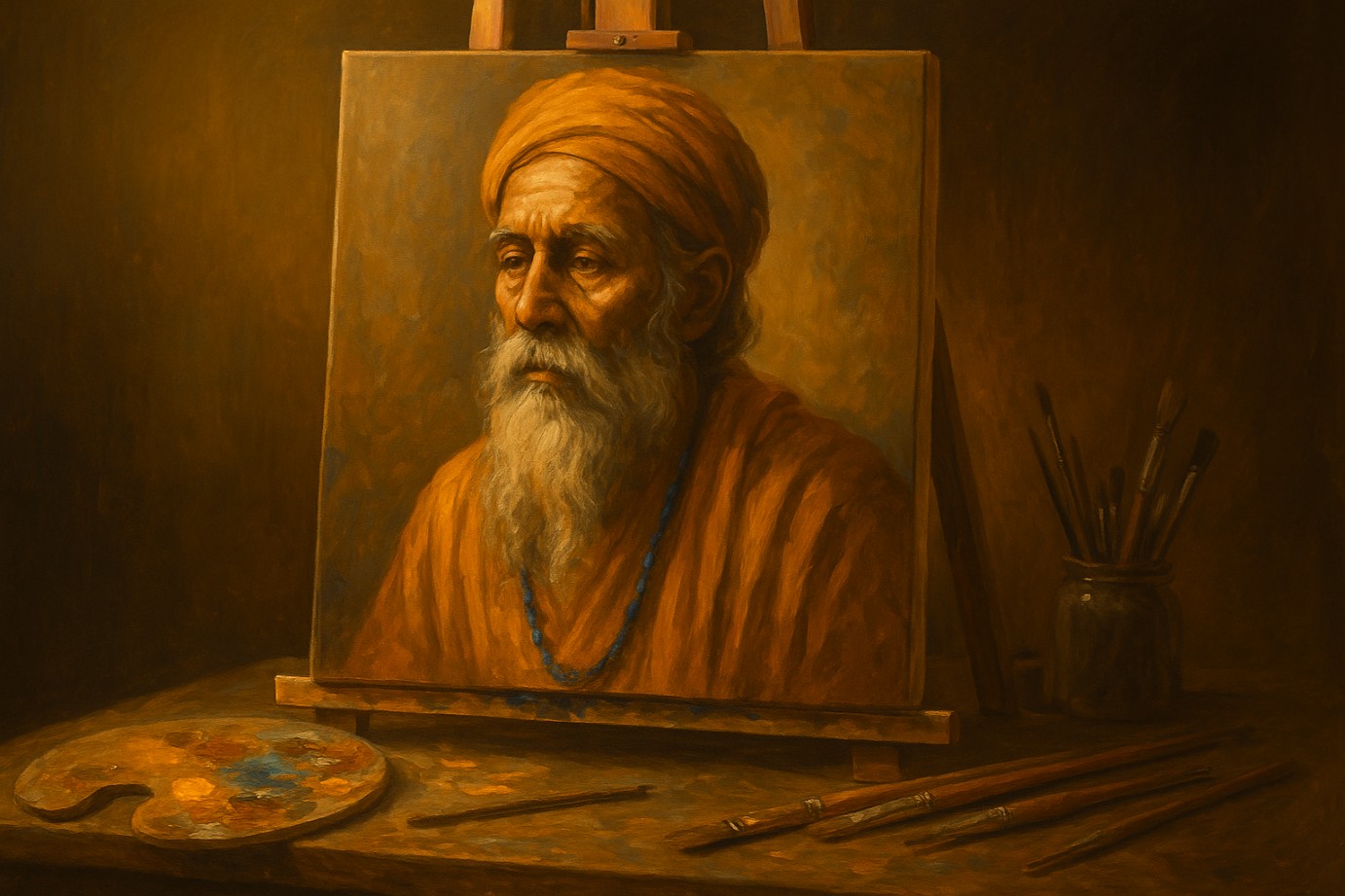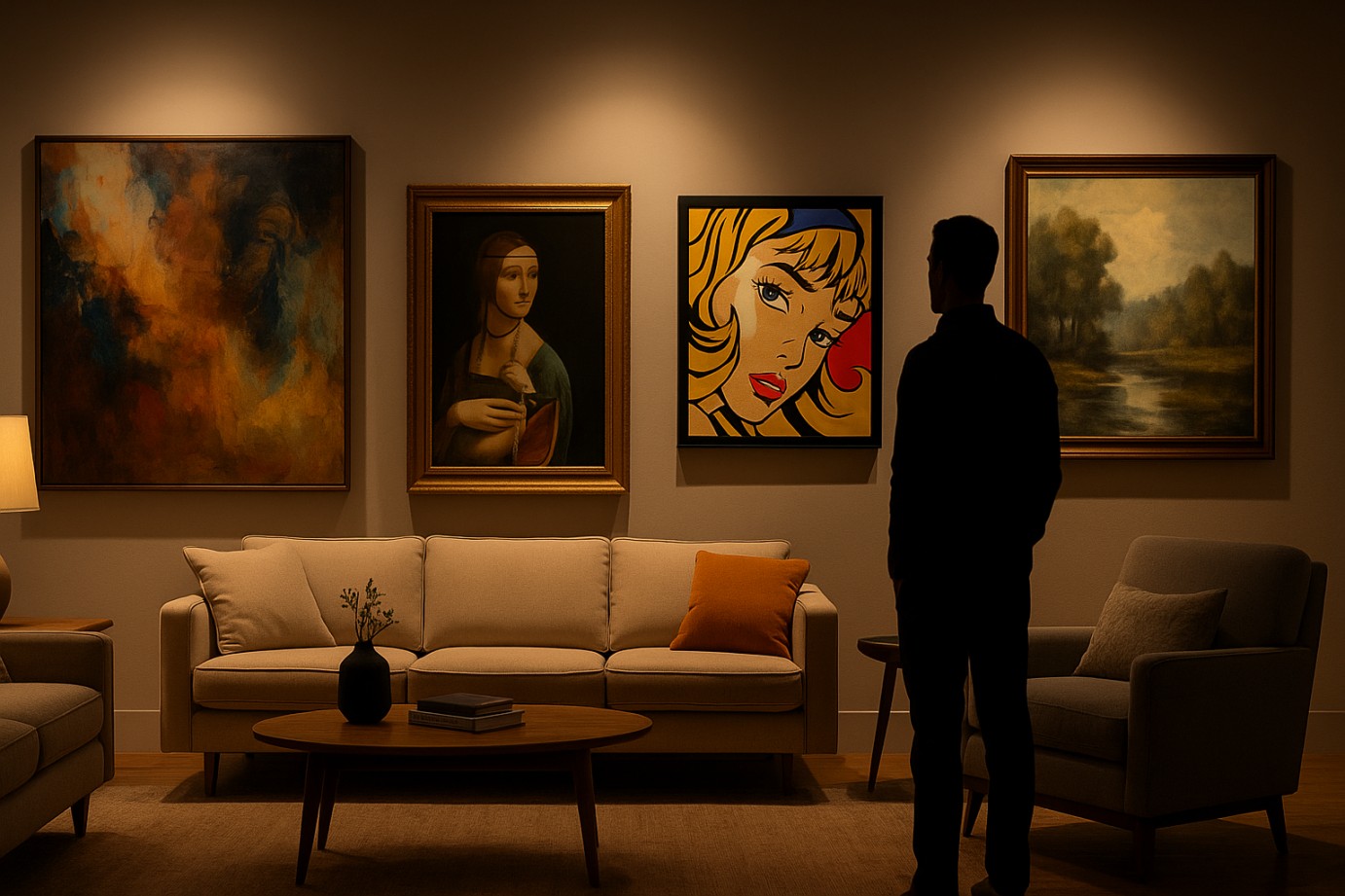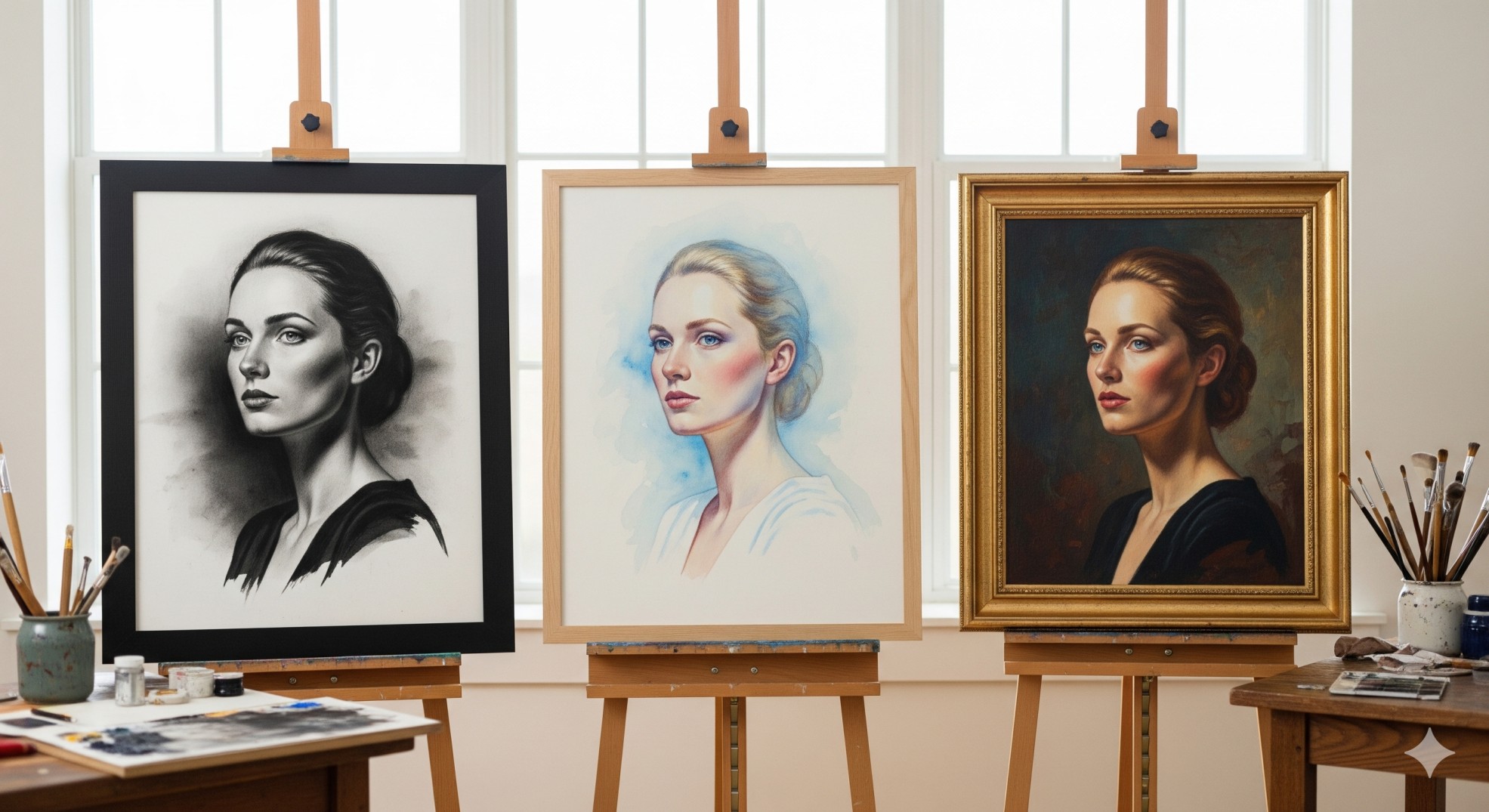In the intimate studios of contemporary artists, canvases bear witness to profound encounters with the sacred. Brushstrokes capture more than physical likeness—they translate the ineffable presence of Hindu ascetics into visual poetry. Contemporary sadhu paintings and drawings represent one of the most compelling intersections in modern spiritual art, where ancient wisdom traditions meet contemporary artistic vision through the timeless mediums of paint, charcoal, and graphite.
The spiritual depth achieved in contemporary sadhu artwork transcends mere portraiture, creating windows into transcendent states of consciousness. These paintings and drawings don’t simply document the appearance of holy men; they attempt to convey the accumulated wisdom, inner peace, and spiritual transformation that radiates from those who have dedicated their lives to the pursuit of moksha—liberation from the cycle of worldly existence.
Through masterful use of color, composition, and traditional artistic techniques, contemporary painters and illustrators are creating works that serve as meditation objects, cultural bridges, and profound artistic statements. These artworks invite viewers into contemplative dialogue with subjects who embody thousands of years of spiritual practice, offering opportunities for personal transformation through the ancient power of painted imagery.
Understanding the Sadhu: The Sacred Subject in Art
To create authentic and spiritually resonant sadhu artwork, contemporary painters must first understand the profound spiritual tradition their subjects represent. Sadhus are Hindu ascetics who have renounced worldly life to pursue spiritual liberation through meditation, yoga, pilgrimage, and devotional practices. The word “sadhu” derives from Sanskrit meaning “to accomplish,” referring to those who seek to accomplish the ultimate goal of self-realization.
The visual symbolism inherent in sadhu appearance provides rich material for artistic interpretation. The sacred ash (vibhuti) that covers many sadhus’ bodies represents the temporary nature of physical existence and the eternal spirit beneath. Their distinctive tilaka markings indicate sectarian affiliation and spiritual philosophy—vertical lines often denoting Vaishnava tradition, horizontal marks indicating Shaivite practice. The flowing hair (jatas) that many sadhus grow represents their rejection of vanity and worldly concerns, while the traditional saffron robes symbolize fire, purification, and spiritual awakening.
Contemporary painters working with sadhu subjects must understand that they are engaging with living representatives of ancient wisdom traditions. The concept of darshan—sacred seeing—suggests that divine presence can be glimpsed through encounter with realized beings. This understanding transforms the act of painting a sadhu from mere portraiture into a form of spiritual practice, requiring the artist to approach their subject with reverence, patience, and genuine spiritual curiosity.
The diversity within sadhu traditions offers artists rich opportunities for exploration. Shaivite sadhus, devoted to Lord Shiva, often display dramatic ash markings and carry tridents (trishuls), while Vaishnavite ascetics may wear distinctive U-shaped tilaka marks and carry prayer beads. Aghori sadhus present particularly striking subjects with their unconventional practices and fierce dedication to transcending all dualities. Each tradition offers unique visual elements that contemporary artists can incorporate into their work while maintaining spiritual authenticity.
The Contemporary Renaissance of Spiritual Art
The current flourishing of sadhu paintings and drawings reflects a broader renaissance of spiritual themes in contemporary fine art. This movement represents a significant departure from the predominantly secular focus that characterized much of 20th-century modernist art, as artists increasingly seek to address fundamental questions about consciousness, meaning, and transcendence through traditional artistic mediums.
This spiritual revival in painting can be traced to pioneering artists like Hilma af Klint, whose abstract spiritual canvases preceded even Kandinsky’s theoretical writings about the spiritual dimensions of art. Contemporary artists creating sadhu portraits follow in this tradition while bringing new cultural perspectives, techniques, and global awareness to their practice. The spiritual depth in contemporary painting now encompasses diverse wisdom traditions, creating rich dialogues between different mystical and artistic approaches.
Several factors have contributed to the growing interest in sadhu artwork among contemporary painters. Globalization has facilitated greater cultural exchange, allowing Western artists unprecedented access to Eastern spiritual traditions. Simultaneously, the rise of mindfulness, meditation, and alternative spirituality in Western culture has created audiences receptive to spiritual art. The digital age, paradoxically, has also increased hunger for authentic, handcrafted works that provide deep contemplative experiences.
Contemporary artists like Wiesław Sadurski exemplify this movement through their dedicated exploration of sadhu portraiture. Sadurski’s paintings capture what he describes as the “spiritual essence and diverse practices” of his subjects, using vibrant colors and expressive brushwork to convey inner radiance and accumulated wisdom. His work demonstrates how traditional painting techniques can be employed to reveal spiritual depth and transformation.
The contemporary approach to spiritual portraiture in painting differs significantly from historical religious art in its emphasis on individual spiritual experience rather than institutional religious doctrine. Modern painters are less concerned with depicting established religious iconography and more interested in capturing the lived reality of spiritual transformation. This shift reflects broader cultural changes toward personal spirituality and the quest for authentic meaning in an increasingly materialistic world.
Artistic Techniques for Painting Spiritual Depth
Creating painted or drawn portraits that convey spiritual depth requires mastery of both technical skills and intuitive understanding of contemplative states. The challenge lies in translating invisible qualities—inner peace, accumulated wisdom, spiritual presence—into visible form through the manipulation of pigment, line, and composition.
Color as Spiritual Language
Color plays a fundamental role in conveying spiritual depth in sadhu artwork. The traditional saffron and orange robes worn by many sadhus carry profound symbolic meaning, representing fire, purification, and the sunrise of spiritual awakening. Contemporary painters often enhance these natural colors or employ sophisticated color relationships to intensify the spiritual atmosphere of their works.
Warm earth tones—ochres, siennas, and umbers—are frequently used to suggest the connection between sadhus and the natural world they often inhabit. These colors also evoke the sacred ash that covers many ascetics’ bodies, creating visual unity between figure and spiritual symbolism. Cool blues and purples may be introduced to suggest transcendence and the infinite sky of consciousness, while strategic use of white can indicate purity, enlightenment, and the dissolution of ego.
The technique of glazing, employed by masters from the Renaissance forward, proves particularly effective in sadhu portraiture. Transparent layers of color build luminosity that seems to emanate from within the painted figure, suggesting inner light and spiritual radiance. This approach requires patience and skill but can produce effects that mere opaque painting cannot achieve.
Drawing Techniques for Spiritual Expression
Contemporary artists working in drawing mediums—charcoal, graphite, pastel, or mixed media—face unique challenges in conveying spiritual depth without the emotional impact of color. Success often depends on masterful manipulation of value, texture, and line quality to suggest both physical presence and spiritual atmosphere.
Charcoal proves particularly effective for sadhu portraits due to its capacity for both subtle gradations and dramatic contrasts. The medium’s inherent connection to fire and transformation resonates with the spiritual themes of the subject matter. Artists can achieve luminous effects by working on toned paper, using the paper’s mid-tone as a starting point while adding both darker shadows and brilliant highlights.
The quality of line becomes crucial in spiritual drawing. Contemplative, flowing lines can suggest the peace and fluidity of meditative states, while more deliberate, architectural lines might indicate the discipline and structure of spiritual practice. The artist’s own state of mind while drawing often translates directly into line quality, making personal spiritual practice valuable preparation for creating authentic spiritual art.
Compositional Strategies for Contemplation
The composition of spiritual paintings must facilitate contemplative viewing rather than merely attracting attention. Many successful sadhu portraits employ centered, symmetrical compositions that promote stillness and focused attention. The use of geometric proportions—such as the golden ratio—can create subliminal harmony that supports meditative viewing.
Eye contact between subject and viewer creates immediate spiritual connection, transforming the viewing experience from passive observation to active encounter. The placement and treatment of the subject’s hands often carry significant meaning—mudras (hand positions) used in meditation and spiritual practice can be incorporated to add layers of symbolic content.
Environmental elements, when included, should support rather than distract from the spiritual focus. Simple backgrounds allow maximum attention on the subject’s presence, while subtle inclusion of spiritual symbols—prayer beads, sacred ash, lotus flowers—can provide context without overwhelming the composition.
The Artist’s Spiritual Preparation
Many contemporary artists creating spiritual portraits report that their own contemplative practice significantly influences their work. The process of meditation, study of spiritual texts, or participation in spiritual communities affects how they perceive and convey spiritual depth in their artwork.
The act of painting itself can become a form of spiritual practice when approached with proper intention. Extended periods of focused attention required for detailed portraiture mirror traditional meditation practices. The artist’s state of consciousness while painting often determines the spiritual quality of the finished work, as only those who have some understanding of contemplative states can hope to convey them authentically.
Traditional Techniques in Contemporary Context
Contemporary sadhu painters often draw upon classical artistic traditions while adapting them for modern spiritual expression. Understanding how traditional techniques can serve spiritual purposes enhances both the artistic quality and contemplative impact of the work.
Classical Portraiture Methods
The alla prima technique, where paintings are completed in a single session while paint remains wet, can capture the immediacy and presence of spiritual encounter. This approach requires confidence and spiritual preparation but can produce works with remarkable vitality and authenticity.
Alternatively, the classical method of developing paintings through multiple sessions—beginning with careful drawing, proceeding through underpainting, and finishing with detailed overpainting—allows for deeper contemplation of the subject and more refined spiritual expression. This slower approach mirrors the gradual nature of spiritual development itself.
Sfumato and Spiritual Atmosphere
Leonardo da Vinci’s sfumato technique—the subtle gradation of tones without harsh outlines—proves particularly effective for spiritual portraiture. This approach creates the soft, luminous quality often associated with enlightened beings while avoiding the sharp materiality that might work against spiritual themes.
The absence of harsh edges in sfumato technique suggests the dissolution of ego boundaries that characterizes advanced spiritual states. Contemporary artists can employ this classical method to create portraits that seem to emerge from and merge back into infinite space.
Chiaroscuro for Spiritual Drama
The dramatic light-dark contrasts of chiaroscuro can powerfully suggest the spiritual journey from ignorance to enlightenment. Caravaggio’s revolutionary use of light as a spiritual metaphor provides a model for contemporary artists seeking to convey the inner illumination of realized beings.
When applied to sadhu portraiture, chiaroscuro can suggest the fire of spiritual transformation, the clarity of awakened consciousness, or the mystery of transcendent states. The technique requires careful consideration of light sources and symbolic meaning to avoid mere theatrical effect.
The Viewer’s Journey: Experiencing Painted Spirituality
Painted and drawn sadhu portraits offer unique opportunities for contemplative experience that differ significantly from photographic imagery. The visible evidence of artistic process—brushstrokes, drawing marks, color mixtures—can enhance rather than distract from spiritual content when handled skillfully.
Art as Meditation Object
Traditional spiritual art has always served contemplative functions, providing focal points for meditation and prayer. Contemporary sadhu paintings continue this tradition, offering viewers opportunities for sustained contemplation that can facilitate deeper states of awareness.
The physical presence of paint on canvas creates a meditation object with tangible spiritual weight. Unlike digital imagery, painted portraits exist as unique material objects that seem to hold spiritual presence in their very substance. Many viewers report feeling drawn to spend extended time with particular paintings, finding that longer contemplation reveals layers of meaning and spiritual insight.
The Alchemy of Pigment and Spirit
There’s something alchemical about the transformation of raw pigments into spiritual imagery. The artist’s process of mixing colors, applying paint, and gradually building form mirrors the spiritual transformation process itself. Viewers can sense this transformation in authentic spiritual paintings, creating connection not only with the portrayed subject but with the creative process that brought the image into being.
The texture and surface quality of paintings add dimensions unavailable in other mediums. The accumulated layers of paint can suggest the accumulated wisdom of the portrayed sadhu, while the visible evidence of artistic struggle and refinement parallels the difficulties and breakthroughs of spiritual practice.
Personal Transformation Through Art
Many people report profound personal experiences when contemplating well-executed sadhu paintings. These encounters can serve as catalysts for viewers’ own spiritual exploration, inspiring meditation practice, study of Eastern philosophy, or simply more mindful living. The paintings function as bridges between ordinary consciousness and expanded awareness.
The transformative potential of these works lies partly in their ability to make abstract spiritual concepts tangible and accessible. By showing individuals who have achieved degrees of spiritual realization, painted portraits offer hope and direction for viewers on their own journeys of self-discovery.
Cultural Sensitivity and Authentic Expression
Contemporary Western artists creating sadhu paintings must navigate complex questions of cultural appropriation, authentic representation, and spiritual responsibility. The act of painting sacred subjects from traditions other than one’s own requires careful consideration of intention, preparation, and presentation.
Avoiding Spiritual Appropriation
The line between appreciation and appropriation in spiritual art depends largely on the artist’s approach and intention. Artists who treat sadhu subjects as exotic curiosities or purely aesthetic objects risk perpetuating colonial attitudes and spiritual superficiality. Authentic spiritual art requires genuine respect for and understanding of the traditions being portrayed.
Successful cross-cultural spiritual painting typically involves extensive preparation—study of relevant philosophical and religious texts, time spent with spiritual communities, and often personal practice of contemplative disciplines. Artists must examine their own motivations and ensure their work serves to honor rather than exploit spiritual traditions.
Building Authentic Understanding
The most respectful approach to painting sadhu subjects involves developing genuine relationships with spiritual communities and teachers. This process often requires years of patient relationship-building and sincere spiritual inquiry. Artists who approach these traditions as students rather than tourists typically create more authentic and spiritually resonant work.
Understanding the philosophical context of sadhu traditions enhances artistic authenticity. Knowledge of concepts like dharma, karma, moksha, and the various yogic paths enriches an artist’s ability to convey spiritual depth through visual means. This understanding should come through serious study rather than superficial research.
Presenting Work Respectfully
How sadhu paintings are presented and contextualized affects their spiritual impact and cultural appropriateness. Artists should provide adequate context about the spiritual traditions they’re portraying, acknowledge their own limitations and learning process, and present their work as sincere artistic inquiry rather than authoritative spiritual statement.
Collaboration with scholars, spiritual teachers, or cultural institutions can help ensure appropriate presentation and interpretation. Many successful exhibitions of cross-cultural spiritual art include educational components that help viewers understand both the artistic and spiritual dimensions of the work.
The Contemporary Art Market for Spiritual Paintings
The growing interest in spirituality and mindfulness has created an expanding market for spiritual artwork, including painted and drawn sadhu portraits. Collectors, practitioners, and institutions seek works that provide contemplative value alongside aesthetic appeal.
Collector Motivations and Values
Collectors of spiritual paintings often describe their acquisitions as investments in personal transformation rather than merely aesthetic objects. Many report that spiritual artworks become integral parts of meditation spaces or daily contemplative practices. The relationship between collector and spiritual artwork tends to be more intimate and personally meaningful than typical art collecting.
Market values for spiritual paintings depend on artistic quality, cultural authenticity, and the artist’s reputation within both art and spiritual communities. Works that demonstrate genuine spiritual understanding alongside technical mastery command premium prices, while superficial treatments of spiritual themes typically have limited market appeal.
Institutional Recognition
Museums and galleries increasingly recognize the importance of spiritual themes in contemporary art. Exhibitions like “Encountering the Spiritual in Contemporary Art” demonstrate growing institutional support for spiritual artwork, including paintings and drawings of spiritual subjects.
This institutional recognition provides validation for artists working with spiritual themes while educating broader audiences about the continued relevance of spiritual art. Museum acquisition of spiritual paintings helps establish market values and artistic legitimacy.
Ethical Considerations in Marketing
The commercialization of spiritual art raises important ethical questions about the commodification of sacred imagery. Artists and dealers must balance legitimate commercial interests with respect for the spiritual traditions being portrayed.
Transparent discussion of artistic process, cultural preparation, and spiritual intention helps distinguish authentic spiritual art from mere commercial exploitation of spiritual imagery. Collectors and institutions increasingly value this transparency and cultural sensitivity.
Teaching and Learning Spiritual Art
The techniques for creating spiritually resonant sadhu paintings can be taught and learned, though the process requires more than technical instruction. Successful spiritual art education combines traditional artistic training with cultural education and contemplative practice.
Technical Skill Development
Students learning to paint spiritual subjects must first master traditional portraiture techniques—understanding of anatomy, color theory, composition, and paint handling. These foundational skills provide the technical means for spiritual expression but are insufficient alone for creating authentic spiritual art.
Advanced techniques like glazing, sfumato, and chiaroscuro require patient practice and skilled instruction. Students benefit from studying classical masters who employed these techniques for spiritual purposes, understanding how technical methods serve spiritual expression.
Cultural and Spiritual Education
Responsible instruction in spiritual art includes substantial cultural and religious education. Students must understand the traditions they’re portraying, the significance of various symbols and practices, and the ethical considerations involved in cross-cultural spiritual art.
This education often involves collaboration with scholars, spiritual teachers, and cultural institutions. Students benefit from firsthand exposure to spiritual communities and practices when possible, though this must be approached with appropriate respect and preparation.
Contemplative Practice for Artists
Many instructors of spiritual art encourage students to develop their own contemplative practices as preparation for creating spiritual artwork. Meditation, yoga, or other spiritual disciplines can enhance artistic sensitivity and authentic expression.
The development of contemplative skills—sustained attention, emotional stability, spiritual curiosity—directly benefits artistic ability while fostering the understanding necessary for authentic spiritual art.
Digital Age Applications and Future Directions
While spiritual painting remains rooted in traditional materials and techniques, digital technologies offer new possibilities for sharing, studying, and experiencing spiritual artwork.
Digital Documentation and Study
High-resolution digital imaging allows detailed study of spiritual paintings that might otherwise be accessible only to museum visitors. Online galleries and virtual exhibitions make spiritual art available to global audiences, supporting the educational and contemplative functions of the work.
Digital tools also facilitate academic study of spiritual art, allowing scholars to compare techniques, trace influences, and document the development of contemporary spiritual painting traditions.
Hybrid Approaches and New Media
Some contemporary artists combine traditional painting techniques with digital elements, creating works that bridge classical and contemporary approaches. These hybrid methods can enhance certain aspects of spiritual expression while maintaining the tactile qualities that make painted works effective meditation objects.
Virtual reality applications may eventually allow immersive experiences with spiritual paintings, though the importance of physical presence and material reality in contemplative practice suggests that traditional painted works will retain unique value.
Global Community Building
Digital platforms facilitate connections between artists, teachers, and practitioners interested in spiritual art. These global communities support learning, cultural exchange, and the development of authentic cross-cultural spiritual art practices.
Online instruction and mentorship make specialized knowledge about spiritual art techniques more widely accessible, supporting the development of this important artistic tradition.
Conclusion: The Enduring Power of Painted Spirituality
Contemporary sadhu paintings and drawings represent a vital continuation of humanity’s oldest artistic tradition—the visual exploration of spiritual reality through handmade imagery. These works serve functions that extend far beyond aesthetic pleasure, offering opportunities for contemplation, cultural understanding, and personal transformation through the ancient power of painted form.
The spiritual depth achieved in the finest contemporary sadhu artwork results from the convergence of technical mastery, cultural sensitivity, and authentic spiritual understanding. These paintings succeed not merely as artistic objects but as vehicles for contemplative experience and encounter with sacred presence. They remind us that art at its highest level has always served spiritual functions, providing windows into transcendent realities that rational discourse alone cannot reach.
As our global culture increasingly recognizes the importance of inner development alongside material progress, spiritual paintings like contemporary sadhu portraits will likely play increasingly important roles in human culture. These works offer something our technology-saturated world desperately needs: opportunities for genuine contemplation, authentic encounter with wisdom traditions, and experiences of beauty that reconnect us with our deepest humanity.
The future of spiritual painting appears promising, with growing institutional recognition, expanding markets, and increasing numbers of serious artists dedicating themselves to this profound artistic calling. Whether displayed in museums, private collections, or meditation spaces, contemporary sadhu paintings will continue serving their essential function: inviting viewers into dialogue with the mystery of human spiritual potential and the profound peace that emerges from authentic self-realization.
In a world often characterized by superficiality and distraction, these painted portraits of individuals who have dedicated their lives to the deepest questions of existence offer something invaluable: tangible evidence that profound transformation is possible, and inspiration for our own journeys toward wisdom, compassion, and inner peace. They stand as testament to the enduring power of traditional artistic mediums to serve not just aesthetic pleasure but the highest human aspirations for meaning, transcendence, and spiritual awakening.




